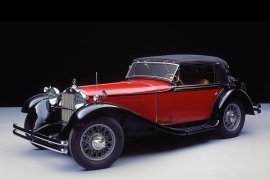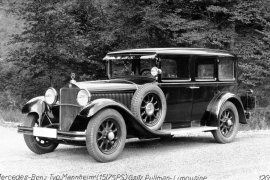MERCEDES BENZ Typ Mannheim Models/Series Timeline, Specifications & Photos
First production year: 1929
Engines: Gasoline
Hans Nibel designed a shorter, open-top version of the Mercedes-Benz Mannheim and introduced it in 1931 at the Berlin Motor Show.
In 1929, after Dr. Ferdinand Porsche left Daimler-Benz AG, Dr. Hans Nibel assumed its role of chief designer. He worked on the existing model 350 designed by his former colleague and improved the car in every possible way. Moreover, it added two convertible versions in 1931, with a long or a short wheelbase, respectively. They also shared the lowered chassis. The shortest version was named Mannheim 370 S, with the internal code WS 10.
Wit a shape that resembled the SSK, the WS10 featured a flat and vertical radiator grille at the front and a chromed bar that supported the big headlights. In front of it, the carmaker installed a chromed bumper-mounted directly on the chassis endings. Behind them, the curved, long wheel fenders continued their lines on the side steps to the rear wheel fenders. Just like its predecessor, the W05 350, it featured a curved engine lid and a flat, but with a shorter windshield. At the back, Mercedes-Benz installed a big trunk, very useful on long journeys.
The leather-clad interior matched the car's status as a personal luxury roadster. Its wooden dashboard featured an instrument panel with four dials. Mercedes-Benz added two glove-compartments on each side for the driver and passenger.
Under the hood, the W10 started with the same 3.5-liter engine as its predecessor, the 350 W05. By 1931, when the convertible WS appeared, Mercedes-Benz already developed an upgraded, 3.7-liter unit. It was an inline-six that provided 75 hp, five more than the 1929 Mannheim.
The Mercedes-Benz Typ Mannheim sedan is a classic car produced by Mercedes-Benz between 1929 and 1934. It was named after the German city of Mannheim, where Mercedes had one of its manufacturing facilities. It was designed by Hans Nibel, who continued Ferdinand Porsche's work.
Also known as the Mercedes W10, the vehicle was based on the previous model of the automaker, the Mercedes Benz W03, and offered a shortened wheelbase and a lighter body paired with inline-six and inline-eight engines that had a capacity between 3.4 liters and 3.8 liters.
A three-speed gearbox helped the car reach a speed of more than 60 mph, as the constructor stated at the time. These features show the adaptation of the car that was made to fulfill the needs of a growing economy and society in the interwar period.
The car's exterior had more rounded edges and a more aerodynamic look. This was to show the early auto industry's significant improvements toward a car that meant a complete package, combining practicability with pleasing aesthetics. The sedan was the only option for the car's body; the other two were a roadster and a limousine.
At the time when the W10 was produced, it was also common to be called Mercedes Benz 14/70 PS. The name referred to the vehicle tax horsepower, a number derived from the capacity of the engine to represent car tax purposes.
The second number refers to the car's actual power, 70 PS being the equivalent of 68 horsepower, a decent power that was constantly upgraded through clever engineering solutions, like a bigger compression ratio, until the model's extinction five years later.
Even in the past century, Mercedes Benz had a reputation for producing comfortable and advanced vehicles equipped with innovative technology meant to attract more and more customers.
The Typ Mannheim sedan was provided with hydraulic cable-operated brakes on all four wheels that helped increase braking power and linearity, delivering more comfort and safety for its passengers. A suspension with leaf springs also contributed to the pleasant ride that the Mercedes offered, providing improved stability.
Even though the car was a synonym for luxury and quality at the time, no more than 2,000 W10 models were sold until the year 1934 when the German manufacturer introduced the following models, the W18 and the W22. The quality of the materials and the car's power were not enough to match the negative parts of the vehicle.
It was a very big and expensive car that came to fruition at a time when the German economy was developing, and the citizens couldn't spend a fortune just for a way of transportation, even if it had some of the best features from the market.

